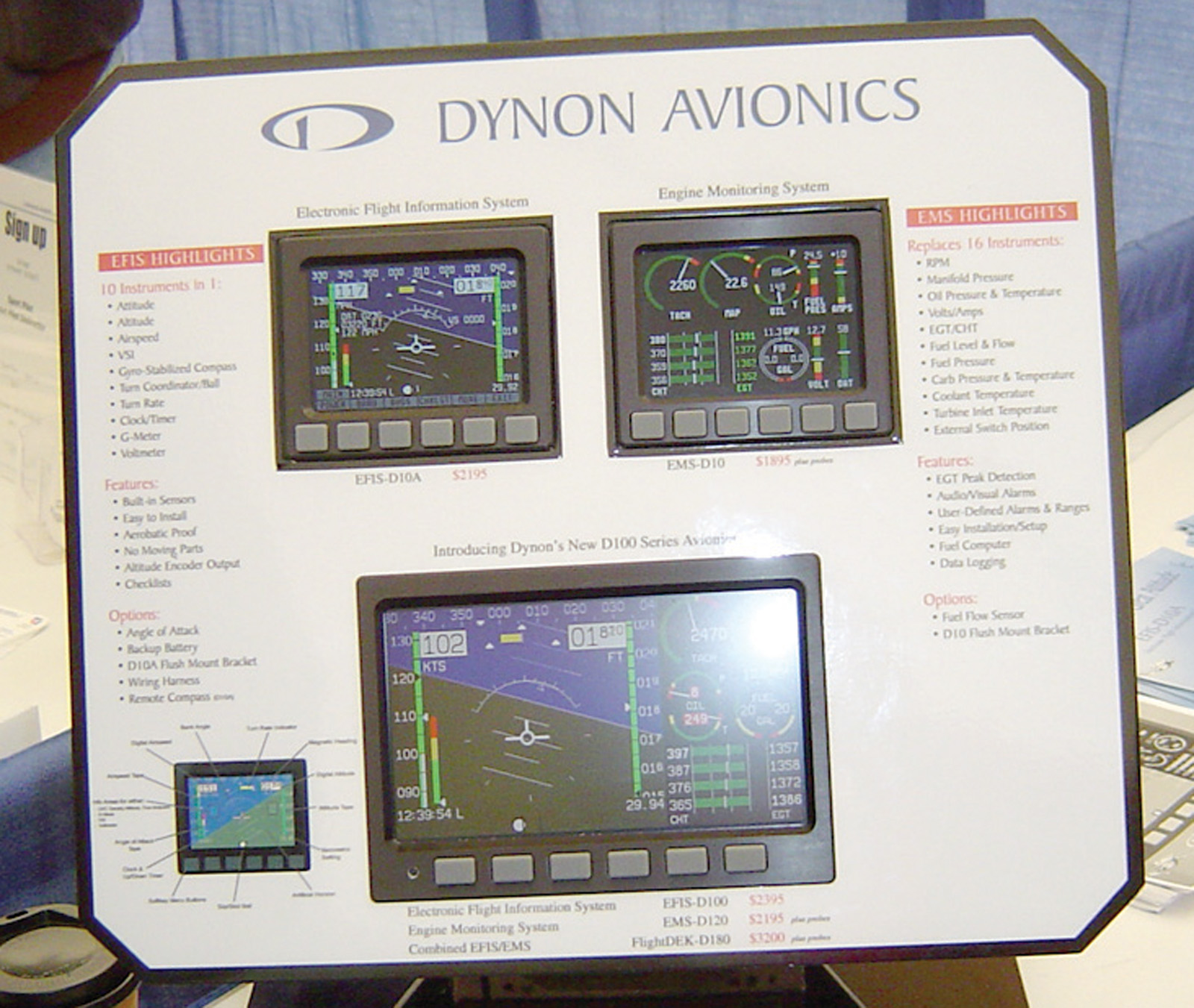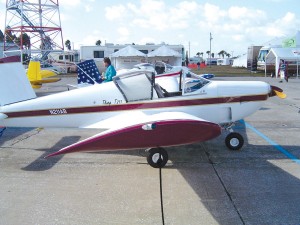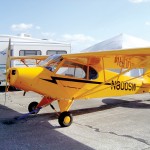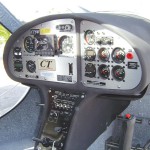By Michael Leighton
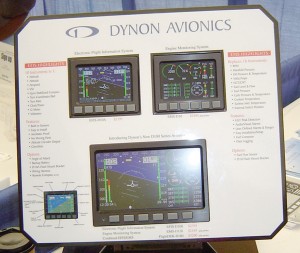 I’ve just returned from the 2005 U.S. Sport Aviation Expo, held in Sebring, Fla. The original show was scheduled for October 27-30, but Hurricane Wilma hindered that plan. The event was actually held January 12-15.
I’ve just returned from the 2005 U.S. Sport Aviation Expo, held in Sebring, Fla. The original show was scheduled for October 27-30, but Hurricane Wilma hindered that plan. The event was actually held January 12-15.
On the day I attended, Saturday, a powerful cold front had moved through Florida, leaving clear blue skies, and winds gusting to 55 miles an hour in its wake. As you might expect, the wind greatly reduced the flying activity at the show, and I suspect the overall attendance.
The sport-pilot universe is still a new place. I’m pleased to report that there was a significant increase in the number of aircraft designs available for purchase, as well as a widening spectrum of designs that included powered parachutes, gyrocopters and conventional fixed-wing aircraft.
For those of you who still aren’t familiar with the new sport pilot rating, it allows the operation of a new category of aircraft called light-sport aircraft. LSA feature a maximum gross takeoff weight of 1,320 lbs (1,430 lbs. for water operations), a maximum stall speed of 51 mph (45 knots),a maximum speed in level flight with maximum continuous power of 138 mph (120 knots) and have a two-seat maximum (pilot and one passenger).
LSA are limited to a single, non-turbine engine only, including rotary and diesel engines, and are equipped with a fixed or ground-adjustable propeller and an un-pressurized cabin. Furthermore, the aircraft feature fixed landing gear (except for seaplanes, allowing the wheels to be rotated for amphibious operation).
The big feature is that these aircraft can be manufactured and sold ready-to-fly under a new special light-sport aircraft certification without FAR Part 23 compliance. Approved aircraft must be manufactured to meet American Society of Testing and Materials consensus standards. Aircraft under this certification may be used for sport and recreation, flight training and aircraft rental.
Furthermore, these aircraft can be licensed as experimental light-sport aircraft if kit- or plans-built. Aircraft under this certification may be used only for sport and recreation and flight instruction for the owner of the aircraft. All LSA aircraft will carry a n FAA registration N-number.
Another big feature is that U.S. or foreign manufacture of light-sport aircraft is authorized. The LSA movement is very popular in Europe, where sport aviation is truly just that–flying for the fun of flying. That is due primarily to the overwhelming cost of operations in Europe. European “sport pilot” equivalents don’t use the aircraft so much for transportation, but for recreation.
A private pilot may operate LSA aircraft at night if the aircraft is equipped per FAR 91.209 and the pilot holds a minimum of a third-class medical. Otherwise they’re restricted to day, VFR conditions below 10,000 feet.
By far, the single most attractive attribute to the sport pilot rating, and thus the light-sport aircraft themselves, is the ability to obtain the rating and operate the aircraft without the need to have an FAA-approved medical certificate.
At virtually every display, during every sales pitch I overheard, and pasted prominently on virtually every window of every new piece of flyable hardware, was the phrase, “No medical required.”
While I totally understand the marketing appeal of an aircraft operator’s rating that doesn’t require a medical certificate, I can’t help but wonder why that attribute is the one that virtually every manufacturer has chosen to emphasize. The rating is too new and the category too young to have any significant data to determine if that feature is in fact “the” key feature in attracting pilots to the category, but it’s certainly worth watching.
From a hardware point of view, the aircraft on display ran the gamut from powered parachute and simple weight shift control to state-of-the-art graphite composite, smooth-as-glass futuristic designs that you can’t help but admire for quality of fit and finish, as well as creature comforts and performance.
The conventional, or fixed-wing aircraft, could be further broken down into two basic categories: those designs with roots based on existing certified aircraft–such as the Legend Cub, the Thorp T-211, 7 AC Champ, Taylorcraft and Zenith–and those designs that developed from a clean sheet of paper specifically to fit the requirements of the LSA category. Those of the certified design genus qualify mostly because their certified counterparts also qualify for LSA status. These designs bear more than a striking resemblance to their certified parents and their lineage is unmistakable to the casual observer.
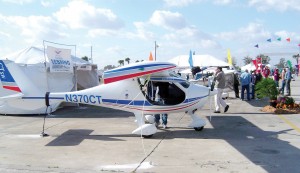
Flight Design’s CT features some slick composite construction, a 49-inch-wide cockpit and extremely well done instrument panel solution.
The LSA-specific designs are the most exciting part of the LSA movement. The Pipistrel Sinus and Flight Design’s CT were two particularly intriguing designs present at the show. The Sinus is really a motorglider that features spoilers for glide path control. Its slick composite airframe yields a respectable 28:1 glide ratio even with fixed tricycle landing gear, as well as delivering a 120-knot cruise speed from the 80-horsepower Rotax engine stuffed in its nose.
Flight Design’s CT features some of the nicest composite construction fit and finish I’ve seen on an aircraft, certified or otherwise, and features an ergonomically comfortable 49-inch-wide cockpit that was commodious even to my 6’1″ frame. Two externally-accessible, flush-fit baggage doors yield access to two baggage compartments that hold up to 50 pounds each. The airplane delivers 112-knot cruise and 1,000-mile range with a 39-knot stall and one of the prettiest instrument panel solutions I’ve ever seen. It utilizes the tried-and-true Rotax powerplant.
A more conventional aircraft of interest is the Tecnam P2002, approved for the LSA category back in May. This was the first time I’d seen it up close. This aircraft is of conventional metal construction, with the liberal use of “pop” style rivets. It also utilizes the Rotax 912 engine as a power source.
Without a doubt, the most intriguing aircraft at this show was the Freebird Extreme, which was displayed in mockup form. The basic platform is a side-by-side, three-wing pusher design that looks like it could be featured in a “Star Wars” episode. The manufacturer, Freebird Sport Aircraft, claims that an LSA version, a piston-powered experimental version and a turboprop experimental version are in flight test and should be displayed at Sun ‘n Fun 2006. It’s an extremely clean design with some terrific performance claims and simply cannot be ignored.
Another proven design represented at the show came from Rans. The Rans S-7C is a certified design that easily made the transition to the LSA category. The S-6 is the side-by-side variant of the same design, which features folding wings. Rans has been building these lightweight designs for a very long time and is well known in the experimental aviation community.
Two common threads that ran through many of the displayed designs is the use of the Rotax engine and the Ballistic Recovery Systems’ parachute systems. These products have developed a reputation for reliability, and the acceptance by the buying public has allowed them to find their way into a majority of the displayed designs.
The Experimental Aircraft Association has carefully shepherded the sport-pilot initiative from conception to implementation and has invested heavily in its success. While it’s clearly too soon to determine whether or not the new sport pilot rating and the associated light-sport aircraft will be a success or not, it’s certainly clear that it’s off to a good start.
Michael Leighton is a 3,800+ CFIIMEI-ATP, as well as an A&P zmechanic and former FAA accident prevention counselor. He operates an on-demand aircraft charter company located in South Florida. He can be reached at mike.leighton@airportjournals.com.











